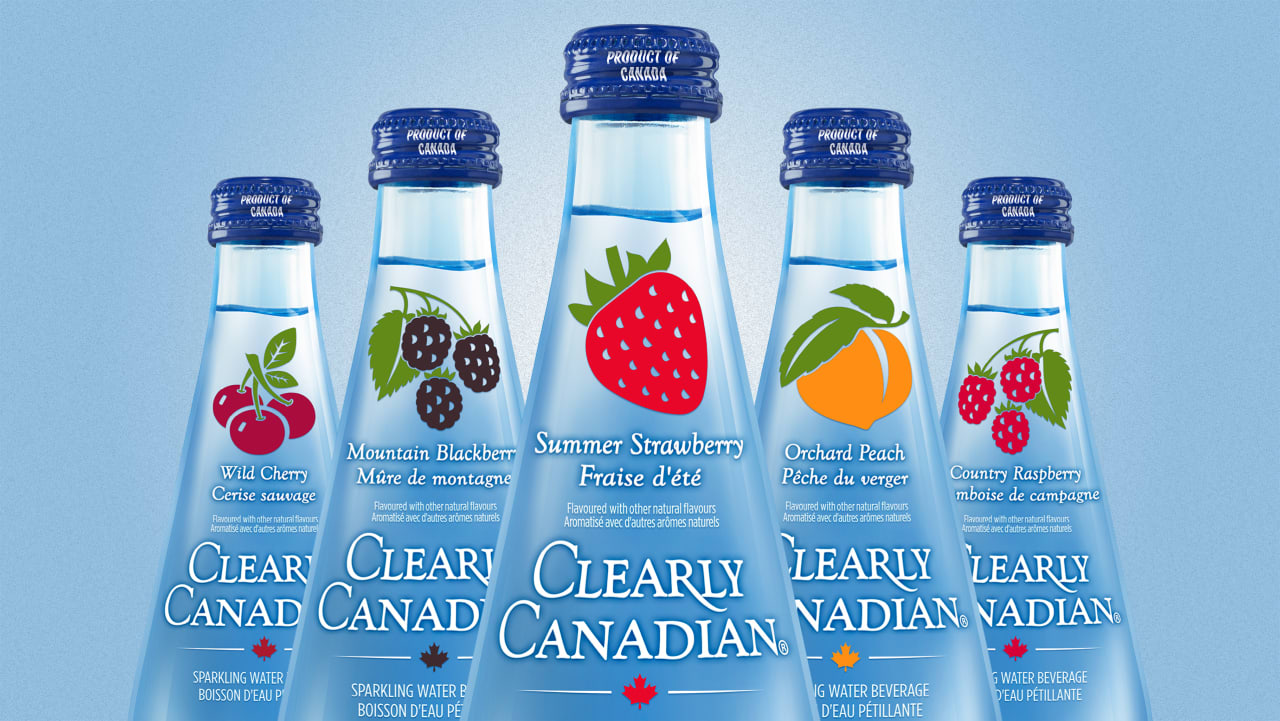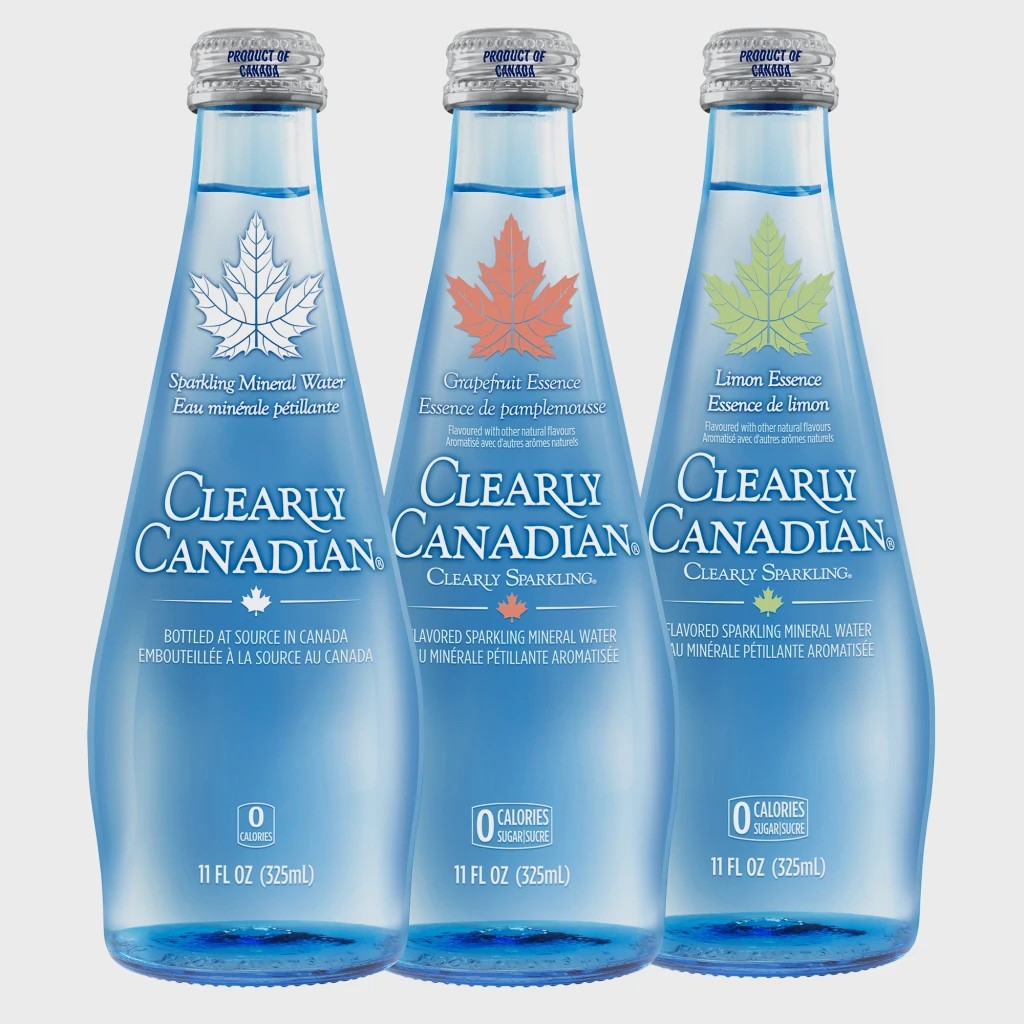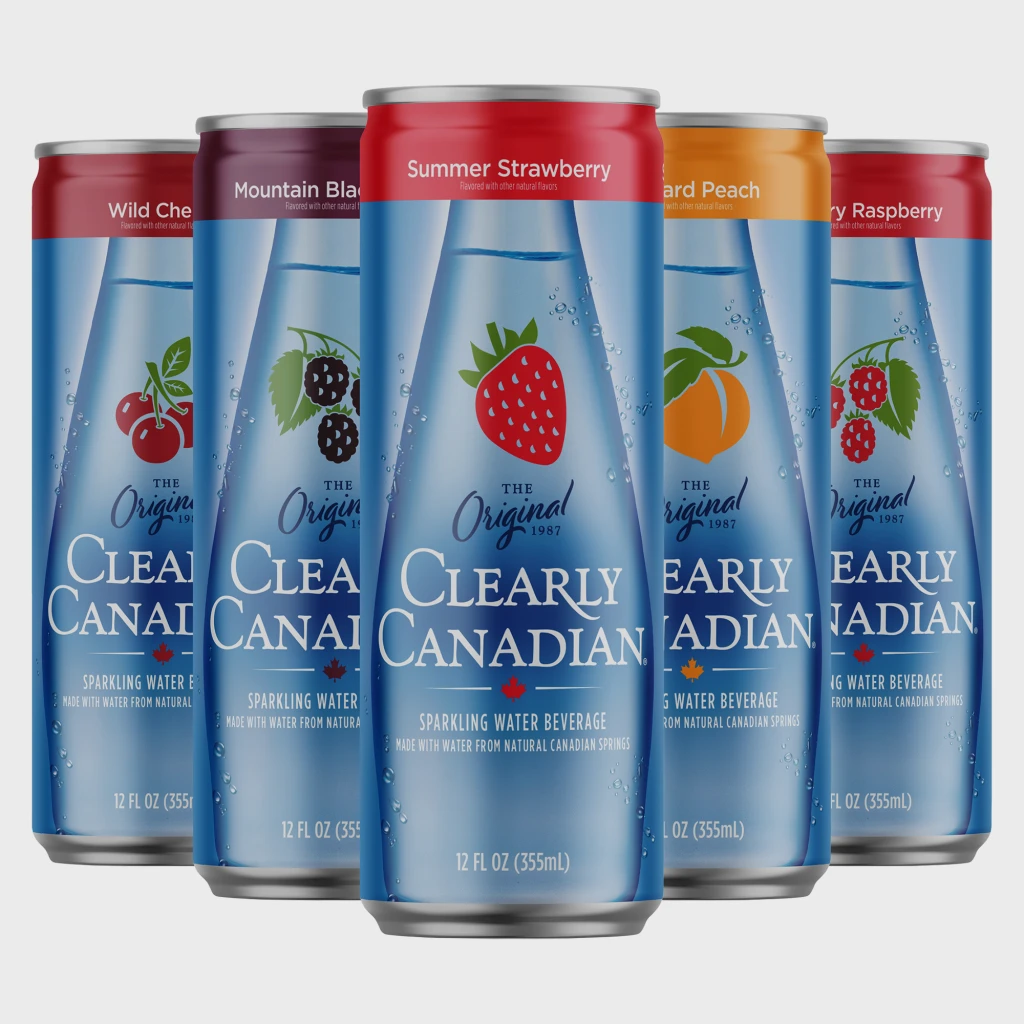Clearly Canadian was an iconic soda in the ’90s. Now it’s back and more popular than ever
Taste is a powerful vessel for time travel. And, well, if you’re going to try to resurrect a nostalgic brand from yesteryear, that time machine better work. It’s 2024, and I’m staring at a new bottle of Clearly Canadian identical to the ones I drank as a kid in the ’90s as an occasional exotic treat. After a premature death and a wild crowdfunded return, the brand is back on its feet—and it’s thriving, with tens of millions of bottles sold, a presence in some 33,600 stores, and new formats and flavors to boot. “When you open a Clearly Canadian, it’s a sensorial experience,” the brand’s Casey Howe says. “You crack open the bottle. You hear the twist. You hear the bubbles, you see them rising. You get the aroma on the nose, and you get that full fruit taste on the palate . . . “ That all sounds a bit like marketing speak. And, well, for good reason: Howe is the VP of marketing at Clearly Canadian. But as I open the signature blue bottle of Orchard Peach on my desk, I’ll be damned if he’s not right. Soon enough, I’m back in an era when Ren & Stimpy was one of the more critical parts of my day and tiny pizzas were served to children in 700-degree cast-iron pans. As it turns out, you can bottle nostalgia—and it’s quite the currency. [Photo: Clearly Canadian] WHAT HAPPENED TO CLEARLY CANADIAN? When Clearly Canadian launched in 1987, it was a bit of an anomaly. Doug Mason and Gordon Sim founded the company in British Columbia, where they had a spring. They began experimenting with fruit fusions using the water and serving it to guests—who loved it. At the time, the beverage market consisted of major soda brands, still water, and plain sparkling water—and “Clearly Canadian was meant to be a bridge between high-sugar, full-of-artificial-stuff soda, and unflavored sparkling water,” says Howe. Featuring natural spring water, and sans any artificial flavors and dyes, it was a brand ahead of its time, and was thus dubbed “new age.” But it worked. In the ’90s, Clearly Canadian boomed to a $280 million property that was distributed in 18 countries. “Unfortunately, the previous company made some mistakes along the way,” Howe says with a chuckle. Among those, Howe notes, was the purchasing of an organic baby food line, the loss of a major distribution agreement, cash mismanagement, the launch and failure of Orbitz, and interpersonal conflicts among leadership. And there were also design shifts that didn’t do the brand any favors—changes in packaging, out-there logo overhauls, and the introduction of plastic, which all confused the market. Collectively, “that unfortunately was the demise of the previous company,” Howe says. Production stopped around 2010, and soon, Clearly Canadian became the stuff of lost nostalgic legend. [Photo: Clearly Canadian] BRINGING THE BUBBLES BACK Not that that was a bad thing, necessarily. As the ’90s began to creep their way back to the forefront of culture, grocery stores, and fashion, people began to yearn for that wholesome thirst quencher of their youth. Entrepreneur Robert R. Khan acquired the company in 2012 and, Howe says, had an idea: to crowdfund a campaign to put Clearly Canadian back into production. It kicked off in 2013/2014 and soon was championed by the likes of viral YouTubers Rhett & Link and others. Howe says Drake and Ryan Gosling bought cases. One superfan in Tokyo alone ordered cases. By the time the campaign wrapped up, fans had preordered some 40,000 cases, which were destined for every U.S. state and Canadian province. Design-wise, Clearly Canadian smartly stuck to playing the hits, using a logo based on the one that dominated in the ’90s, and deploying the original fruit icons from the era, as well as that iconic blue bottle and, of course, the classic recipes. Problem was, for various reasons, it took a long time to get fully back into production and fulfill all those orders—and people were, naturally, pissed. As the company wrote on its website, “Anyone who’s ever participated in crowdfunding knows that it’s not all sunshine and roses. The costs and complexities of sourcing bottle manufacturing, ingredients, flavors, package design, trays, wraps, shipping, etc., all took longer than we’d hoped. Nevertheless, our pre-order fans stuck with us, and, after a small run of Country Raspberry in early 2016, our fans were able to enjoy [their] first Clearly Canadian in years.” Fans indeed stuck by the brand despite the delays—and when the company resumed full-scale production in 2017, Howe says, they sold through an eight-month forecast in about three weeks. The challenge, he adds, was this: How do you return Clearly Canadian to the top of its game—and how do you do so without repeating the mistakes of the past? [Photo: Clearly Canadian] CLEARLY CAN-ADIAN? After production resumed, the brand relaunched in World Market, Hy-Vee, and Canadian 7-Elevens, and did just under $4 million in sales. Howe says they were

Taste is a powerful vessel for time travel. And, well, if you’re going to try to resurrect a nostalgic brand from yesteryear, that time machine better work.
It’s 2024, and I’m staring at a new bottle of Clearly Canadian identical to the ones I drank as a kid in the ’90s as an occasional exotic treat. After a premature death and a wild crowdfunded return, the brand is back on its feet—and it’s thriving, with tens of millions of bottles sold, a presence in some 33,600 stores, and new formats and flavors to boot.
“When you open a Clearly Canadian, it’s a sensorial experience,” the brand’s Casey Howe says. “You crack open the bottle. You hear the twist. You hear the bubbles, you see them rising. You get the aroma on the nose, and you get that full fruit taste on the palate . . . “
That all sounds a bit like marketing speak. And, well, for good reason: Howe is the VP of marketing at Clearly Canadian. But as I open the signature blue bottle of Orchard Peach on my desk, I’ll be damned if he’s not right. Soon enough, I’m back in an era when Ren & Stimpy was one of the more critical parts of my day and tiny pizzas were served to children in 700-degree cast-iron pans.
As it turns out, you can bottle nostalgia—and it’s quite the currency.

WHAT HAPPENED TO CLEARLY CANADIAN?
When Clearly Canadian launched in 1987, it was a bit of an anomaly. Doug Mason and Gordon Sim founded the company in British Columbia, where they had a spring. They began experimenting with fruit fusions using the water and serving it to guests—who loved it. At the time, the beverage market consisted of major soda brands, still water, and plain sparkling water—and “Clearly Canadian was meant to be a bridge between high-sugar, full-of-artificial-stuff soda, and unflavored sparkling water,” says Howe. Featuring natural spring water, and sans any artificial flavors and dyes, it was a brand ahead of its time, and was thus dubbed “new age.” But it worked. In the ’90s, Clearly Canadian boomed to a $280 million property that was distributed in 18 countries.
“Unfortunately, the previous company made some mistakes along the way,” Howe says with a chuckle.
Among those, Howe notes, was the purchasing of an organic baby food line, the loss of a major distribution agreement, cash mismanagement, the launch and failure of Orbitz, and interpersonal conflicts among leadership. And there were also design shifts that didn’t do the brand any favors—changes in packaging, out-there logo overhauls, and the introduction of plastic, which all confused the market. Collectively, “that unfortunately was the demise of the previous company,” Howe says.
Production stopped around 2010, and soon, Clearly Canadian became the stuff of lost nostalgic legend.

BRINGING THE BUBBLES BACK
Not that that was a bad thing, necessarily.
As the ’90s began to creep their way back to the forefront of culture, grocery stores, and fashion, people began to yearn for that wholesome thirst quencher of their youth. Entrepreneur Robert R. Khan acquired the company in 2012 and, Howe says, had an idea: to crowdfund a campaign to put Clearly Canadian back into production. It kicked off in 2013/2014 and soon was championed by the likes of viral YouTubers Rhett & Link and others. Howe says Drake and Ryan Gosling bought cases. One superfan in Tokyo alone ordered cases. By the time the campaign wrapped up, fans had preordered some 40,000 cases, which were destined for every U.S. state and Canadian province.
Design-wise, Clearly Canadian smartly stuck to playing the hits, using a logo based on the one that dominated in the ’90s, and deploying the original fruit icons from the era, as well as that iconic blue bottle and, of course, the classic recipes.
Problem was, for various reasons, it took a long time to get fully back into production and fulfill all those orders—and people were, naturally, pissed.
As the company wrote on its website, “Anyone who’s ever participated in crowdfunding knows that it’s not all sunshine and roses. The costs and complexities of sourcing bottle manufacturing, ingredients, flavors, package design, trays, wraps, shipping, etc., all took longer than we’d hoped. Nevertheless, our pre-order fans stuck with us, and, after a small run of Country Raspberry in early 2016, our fans were able to enjoy [their] first Clearly Canadian in years.”
Fans indeed stuck by the brand despite the delays—and when the company resumed full-scale production in 2017, Howe says, they sold through an eight-month forecast in about three weeks.
The challenge, he adds, was this: How do you return Clearly Canadian to the top of its game—and how do you do so without repeating the mistakes of the past?

CLEARLY CAN-ADIAN?
After production resumed, the brand relaunched in World Market, Hy-Vee, and Canadian 7-Elevens, and did just under $4 million in sales. Howe says they were focused on regaining distribution, and they’ve since done just that, landing in Kroger, Albertsons, Publix, and various other stores. The brand is currently expanding its presence in Walmart and Target, and is also on rotation at Costco . . . and Howe says they’ve done it all without trying to balloon too fast or bite off more than they can chew. To that end, he adds that his team is just around 24 people scattered across North America (currently, a group of private investors who are fans of the brand from the ’90s own it).
“We’re doing phenomenally well,” Howe says. Last year, Clearly Canadian announced that it had shipped 50 million bottles since its 2017 production resurrection. Currently, Howe notes, they are on track to sell around 45 million bottles this year alone.
Howe says the company is currently working with an agency on a 2025 campaign articulating what it stands for, and how they can attract new consumers—especially millennials and Gen Z folks whose tastes and values could align with Clearly Canadian’s—while growing awareness from former fans who don’t even realize the drink is back.
Last summer, they also launched their first line of new products since the 2017 comeback, a zero-sugar/zero-calorie line consisting of Forest Blackberry, Fresh Cherry, Citrus Medley, and Tropical Splash, and an Essence line of carbonated spring water with natural vegan flavors. The brand just introduced cans to its line of originals and zero-sugar options as well, so Clearly Canadian can go where breakable bottles cannot. (As a reminder of what you’re about to consume, the can contains an image of the brand’s signature . . . bottle.)
Howe says the cans have been performing well in the markets where they’re being tested, and they’ve been attracting 45% new consumers to the franchise. Plans are currently in the works to expand them in a “big way” next year.
Sadly, the one thing you won’t see any time soon: the return of Orbitz. The old overlords sold the trademark, and, well, “the machine that made the Orbitz spheres broke down, so it was sold off for parts.”
Until they figure out a way to rebuild it, for the time being, ’90s imbibers will have to stick to the thunderous return of Clearly Canadian.
“I’ve always told people, the reason I’m here is I’ve never seen a brand perform like this, and I’ve never seen a brand with such crazy-strong consumer affinity and desire,” Howe says. “So the future is very bright.”






















